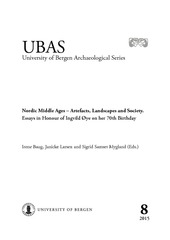| dc.contributor.author | Ersland, Geir Atle | |
| dc.contributor.editor | Baug, Irene | |
| dc.contributor.editor | Larsen, Janicke | |
| dc.contributor.editor | Mygland, Sigrid Samset | |
| dc.date.accessioned | 2017-01-16T10:34:32Z | |
| dc.date.available | 2017-01-16T10:34:32Z | |
| dc.date.issued | 2015 | |
| dc.identifier.isbn | 978-82-90273-89-2 | |
| dc.identifier.issn | 0809-6058 | |
| dc.identifier.uri | https://hdl.handle.net/1956/15400 | |
| dc.description.abstract | In 1976, Bryggen’s Museum opened its doors to an audience that for more than twenty years had heard reports of extraordinary discoveries and rare objects found during the archaeological excavations at Bryggen. Following a fire in July 1955, a long-term project had produced scientific results which had been expected to clarify the validity of earlier hypotheses on how the harbour town of Bergen had developed from c. 1100 and through the medieval period. The fire in 1955 took place at a time when public opinion to Bryggen as cultural heritage could, at best, be described as indifferent , if not strongly in favour of redeveloping the entire area. After the Second World War, most people were more concerned with creating a better future rather than contemplating the past, and as many as 85% of the citizens of Bergen are likely to have been in favour of demolishing and redeveloping the area in 1946 (Lidén 2012, 50). The archaeological excavations after 1955 were a landmark enterprise, and soon became renowned within the international community of urban archaeologists. On the one hand, when evaluating the outcome in retrospect, perhaps one of the most important results was the extent to which archaeology came to influence public opinion on the question of preserving the remaining parts of Bryggen. On the other hand, to the scholarly community it was a confirmation of the hypothesis of Bryggen’s significance as an historical monument. The characteristic tenements rebuilt after the catastrophic town fire in 1702 had been left almost untouched until the southern half was demolished and redeveloped in the years 1900-12. Not so well known is that the redevelopment provided an opportunity for the director of Det hanseatiske Museum (the Hanseatic Museum), Johan Christian Koren Wiberg, to conduct pioneering urban archaeological research, which one could argue was crucial for saving the remaining tenements and protecting them under the Cultural Heritage Act as early as 1927. In the following, I will try to shed some light on Koren Wiberg’s achievements and how his interpretation of his archaeological observations contributed to The Cultural Heritage Act of 1927. | eng |
| dc.language.iso | eng | eng |
| dc.publisher | University of Bergen | eng |
| dc.relation.ispartof | UBAS - University of Bergen Archaeological Series 8. Nordic Middle Ages - Artefacts, Landscapes and Society. Essays in Honour of Ingvild Øye on her 70th Birthday | |
| dc.relation.ispartofseries | UBAS, University of Bergen Archaeological Series; 8 | eng |
| dc.rights | Attribution CC BY NC SA | eng |
| dc.rights.uri | https://creativecommons.org/licenses/by-nc-sa/3.0 | eng |
| dc.title | How Archaeology Saved Bryggen | eng |
| dc.type | Chapter | eng |
| dc.type | Peer reviewed | eng |
| dc.description.version | publishedVersion | |
| dc.rights.holder | Copyright the author | eng |
| dc.source.pagenumber | 145-157 | |
| dc.subject.nsi | VDP::Humaniora: 000::Arkeologi: 090 | |
| dc.identifier.citation | In: Irene Baug, Janicke Larsen and Sigrid Samset Mygland (Eds.), Nordic Middle Ages - Artefacts, Landscapes and Society. Essays in Honour of Ingvild Øye on her 70th Birthday, p 145-157, UBAS - University of Bergen Archaeological Series; 8. | |
| dc.source.volume | 8 | |

